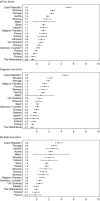Preterm birth time trends in Europe: a study of 19 countries
- PMID: 23700966
- PMCID: PMC4285908
- DOI: 10.1111/1471-0528.12281
Preterm birth time trends in Europe: a study of 19 countries
Abstract
Objective: To investigate time trends in preterm birth in Europe by multiplicity, gestational age, and onset of delivery.
Design: Analysis of aggregate data from routine sources.
Setting: Nineteen European countries.
Population: Live births in 1996, 2000, 2004, and 2008.
Methods: Annual risk ratios of preterm birth in each country were estimated with year as a continuous variable for all births and by subgroup using log-binomial regression models.
Main outcome measures: Overall preterm birth rate and rate by multiplicity, gestational age group, and spontaneous versus non-spontaneous (induced or prelabour caesarean section) onset of labour.
Results: Preterm birth rates rose in most countries, but the magnitude of these increases varied. Rises in the multiple birth rate as well as in the preterm birth rate for multiple births contributed to increases in the overall preterm birth rate. About half of countries experienced no change or decreases in the rates of singleton preterm birth. Where preterm birth rates rose, increases were no more prominent at 35-36 weeks of gestation than at 32-34 weeks of gestation. Variable trends were observed for spontaneous and non-spontaneous preterm births in the 13 countries with mode of onset data; increases were not solely attributed to non-spontaneous preterm births.
Conclusions: There was a wide variation in preterm birth trends in European countries. Many countries maintained or reduced rates of singleton preterm birth over the past 15 years, challenging a widespread belief that rising rates are the norm. Understanding these cross-country differences could inform strategies for the prevention of preterm birth.
Keywords: Europe; indicated preterm births; multiple births; preterm births; time trends.
© 2013 The Authors. BJOG: An International Journal of Obstetrics & Gynaecology published by John Wiley and Sons on behalf of the Royal College of Obstetricians and Gynaecologists.
Figures



Comment in
-
Preterm birth time trends in Europe: the worrying case of Greece.BJOG. 2014 Feb;121(3):372-3. doi: 10.1111/1471-0528.12529. BJOG. 2014. PMID: 24428453 No abstract available.
References
-
- EURO-PERISTAT project in collaboration with SCPE, EUROCAT and EURONEOSTAT . Better statistics for better health for pregnant women and their babies in 2004. European Perinatal Health Report 2008. 2008. Available at www.europeristat.com.
-
- Larroque B, Ancel PY, Marret S, Marchand L, Andre M, Arnaud C, et al. Neurodevelopmental disabilities and special care of 5-year-old children born before 33 weeks of gestation (the EPIPAGE study): a longitudinal cohort study. Lancet. 2008;371:813–20. - PubMed
-
- Zeitlin J, Draper ES, Kollee L, Milligan D, Boerch K, Agostino R, et al. Differences in rates and short-term outcome of live births before 32 weeks of gestation in Europe in 2003: results from the MOSAIC cohort. Pediatrics. 2008;121:e936–44. - PubMed
-
- Kramer MS, Demissie K, Yang H, Platt RW, Sauve R, Liston R. The contribution of mild and moderate preterm birth to infant mortality. Fetal and Infant Health Study Group of the Canadian Perinatal Surveillance SystemJAMA. 2000;284:843–9. - PubMed
-
- Gouyon JB, Vintejoux A, Sagot P, Burguet A, Quantin C, Ferdynus C. Neonatal outcome associated with singleton birth at 34–41 weeks of gestation. Int J Epidemiol. 2010;39:769–76. - PubMed
Publication types
MeSH terms
LinkOut - more resources
Full Text Sources
Other Literature Sources
Medical
Molecular Biology Databases
Miscellaneous

